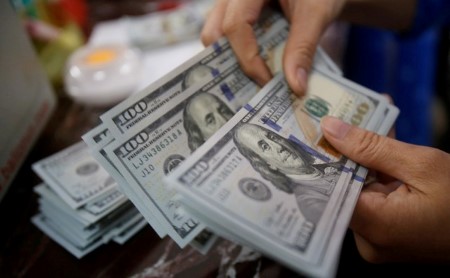




Philippines Trade Update: Trade trajectories trend along
 DOWNLOAD
DOWNLOAD

Policy Rate Updates: Double cut finale
 DOWNLOAD
DOWNLOAD

Monthly Economic Update: One for the road
 DOWNLOAD
DOWNLOAD


Hedge funds most cautious on dollar in 2 months

ORLANDO, Fla., July 4 (Reuters) – Speculators have cut their net long dollar position to a two-month low, but this is not necessarily evidence of a more fundamental souring of sentiment toward the greenback.
At least not yet.
While the ebbing of US rate hike expectations recently has eroded the dollar’s rate appeal, none of its G4 rivals are glowing alternatives. The Federal Reserve is still expected to outgun its peers when it comes to raising interest rates.
Indeed, funds scaling back their bullish bets on the dollar may be simply taking profit, clearing the decks, and preparing to build the net long position up again, which would probably help push the currency to retest June’s 20-year high.
US futures market data show that the hedge funds reduced their net long dollar position against other G10 currencies by USD 2 billion to USD 14 billion in the week to June 28. It was the first decline in three weeks.
Six weeks ago, funds’ net long position nudged USD 21 billion.
Much of the Commodity Futures Trading Commission’s dollar position shift was in sterling. Funds reduced their net short sterling position by around 10,000 contracts to 53,000 contracts, the smallest net short position since early April.
It marked the fifth week in a row that funds have scaled back their bearish bets against the pound, and was the biggest shift since February.
But sterling is trading heavily and last week dipped back below USD 1.20 after data showed that Britain in the first three months of the year recorded its widest current account deficit since the 1950s, of more than 8% of GDP.
The pound has fallen 10% against the dollar this year. That’s more than the euro’s fall against the dollar, even though the Bank of England has raised rates by more than 100 basis points since December.
A long position is effectively a bet that an asset will rise in value, and a short position is a bet it will fall in value.
EURO PAIN, YEN SHOCK?
The CFTC report also showed that funds retained a net short euro position for the third week in a row but trimmed it slightly. Euro positioning is light, and could go either way, but the pressure appears to be building to the downside.
There’s a growing view that the euro zone is hurtling towards a potentially nasty recession, one that the European Central Bank will struggle to mitigate because inflation is well above target. If that wasn’t enough, the ECB also needs to rein in widening sovereign yield spreads.
According to analysts at Bank of America, rate hikes of 50 basis points has become “the norm for many central banks.” But not the ECB.
“The euro is increasingly being left behind in the global rate hiking cycle. We think that the path of least resistance remains for a weaker euro through the summer,” they wrote on Friday.
Meanwhile, CFTC funds reduced their net short yen position for the seventh consecutive week to the smallest this year at around 52,000 contracts. Their bearish bet on the Japanese currency has more than halved in that time, and is now worth less than USD 5 billion.
BofA analysts reckon the yen will remain under pressure because the Bank of Japan is the “last dove standing”, as it maintains its ‘yield curve control’ policy of buying however many bonds necessary to cap the 10-year yield at 0.25%.
The yen last week slipped to a fresh 24-year low of 137.00 per dollar, and its upside potential in the near term looks limited – funds have been reducing their short position for several weeks, yet the yen has continued to slide.
But Robin Brooks at the Institute for International Finance warns that yen bears are about to get a “harsh reality check” if the world slips into recession.
“The Yen always strengthens when adverse shocks hit. We’re about to see a big unwind and reversal of recent Yen weakness…” Brooks tweeted on Sunday.
(By Jamie McGeever. The opinions expressed here are those of the author, a columnist for Reuters.)
This article originally appeared on reuters.com





 By Reuters
By Reuters